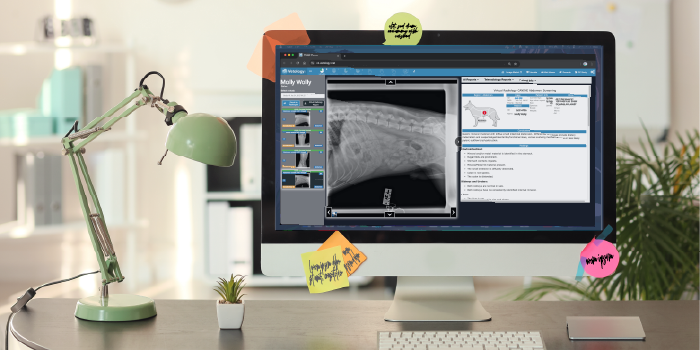Veterinary care has advanced rapidly in recent years, but better medicine often comes at a cost. As prices for veterinary services steadily rise, clinics find themselves dealing with higher overhead costs, and clients may weigh the cost of services more heavily than potential outcomes when deciding on a treatment plan for their pet.
Veterinary practices, especially general practice clinics, face pressure to balance budgets against the necessity of high-quality patient care. Veterinary teleradiology is one solution to this dilemma, bringing the expertise of board-certified veterinary radiologists into the GP setting in a cost-effective way.
Here’s how veterinary teleradiology helps reduce costs without compromising care.
Key takeaways:
- Veterinary teleradiology and AI-powered image analysis improve diagnostic speed and accuracy.
- Collimating to the area of concern and leveraging AI to pre-screen images provides radiologists with quality images and helps guide questions to the radiologist when a consultation is needed.
- Modern teleradiology platforms are affordable and equipment-light, which reduces expenses for veterinary hospitals.
Fast and Accurate Diagnoses
We all know what veterinary teleradiology does: it connects veterinary hospitals and clinicians in urgent care and general practices with board-certified veterinary radiologists who interpret digital diagnostic imaging, such as radiographs, dental radiographs, ultrasounds, CT scans, and MRI studies. With fast turnaround times – often within a few hours for STAT radiology cases – clinicians can make informed treatment decisions sooner and improve patient outcomes.
When AI-powered radiology screening reports are added to the workflow, the benefits multiply.
Artificial intelligence in veterinary radiology can analyze images and provide instant preliminary radiology reports that help clinical teams confirm findings without escalating a case to a radiologist. This speeds up decision-making and can eliminate the need for additional consults.
Targeted Studies
In many cases, veterinarians can initiate treatment with a focused radiographic study guided by the pet’s clinical history.
By collimating to the region of interest, positioning the patient correctly, and capturing multiple views, clinicians can produce higher-quality images that improve accuracy for both AI interpretation and radiologist reviews.
Hands-free restraint techniques and the use of positioning aids not only ensure safety but also produce sharper, diagnostic-quality images.
Using appropriate exposure settings, sedation when needed, and foam supports to maintain symmetry contributes to consistent, high-quality images that optimize AI radiology analysis and improve radiologist interpretation.
When selecting a veterinary teleradiology provider, look for one that charges per region rather than per image, so you can capture as many diagnostic views as needed without increasing costs. In many cases, a clear AI-powered or radiologist-reviewed report may provide enough information to guide clinical decision-making and avoid additional testing, saving time, cost, and stress for both the patient and the care team.
Board-certified Expertise
Instant access to board-certified veterinary radiologists was once limited to clients and patients of specialty hospitals. However, AI-enabled screening results paired with veterinary teleradiology services can now bring radiologist expertise to general practice clinics. When cases require more detail than an AI read provides, clinicians can easily escalate directly to a board-certified radiologist. This targeted use of human expertise ensures radiologists’ time is reserved for cases where it’s most impactful.
Easy Integration and Storage
Vetology’s veterinary imaging AI subscription includes secure storage of radiology reports and DICOM files, along with free access to an integrated PACS. This centralized image storage keeps prior studies accessible, enabling radiologists and clinicians to compare current images with historical ones for lesion tracking, disease progression monitoring, and treatment evaluation. By maintaining a continuous diagnostic record, practices can reduce the need for repeat imaging and support long-term patient care.
Integration with practice management software or AI Scribe means fewer clicks for your team and faster report turnaround.

Case Report: Suspicious Gas Pattern
Vomiting pets are a daily occurrence in general practice, and these patients frequently require X-rays to rule out an intestinal obstruction. Abdominal gas and fluid patterns are particularly challenging for many veterinarians, including seasoned veterans, and image interpretation is critical in deciding which of these cases require surgery and which are best managed conservatively.
Take the case of Molly, a 5-year-old Labrador, who presents with acute vomiting. Molly is large, so radiographs are collimated to the upper and lower abdomen in overlapping views. Noting nothing immediately obvious, the clinician reviews the virtual AI radiologist report, which has also analyzed the images.
The AI report highlights an abnormal gas pattern suspicious for a linear obstruction. This immediate feedback prompts the clinician to prioritize Molly’s case, begin supportive care, and discuss the potential need for surgery with the client.
Molly’s owner agrees to a second-opinion teleradiology consultation to confirm the diagnosis before subjecting Molly to major surgery, and the clinician escalates the case to a board-certified veterinary radiologist from within the same platform. Within a few hours, the radiology report confirms a linear foreign body, and Molly goes to surgery. Because Vetology charges by region rather than by the number of images, the doctor can submit all abdominal views without incurring an added cost to the owner.
In Molly’s case, the AI-radiologist screening report provided immediate feedback on X-ray images, preventing delays and enabling the team to allocate appropriate staff time to Molly’s care. Then, the radiologist’s review delivered diagnostic confirmation, giving the clinician and Molly’s parents confidence to move forward with surgery.

